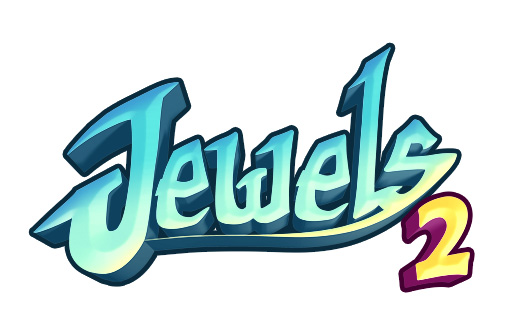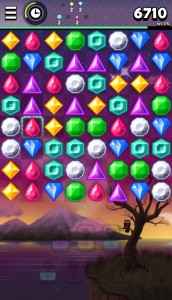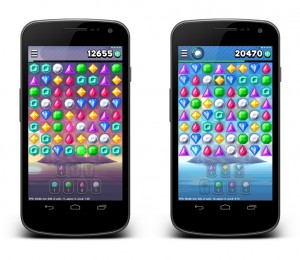The release draws near…
Got some cool news for you: it looks like I might make it for a May 31st release with Jewels 2! (Android only, iOS will be coming later.) That's like, this Friday, right? Pretty cool if you ask me. 😄
As the Jewels players on Android have suffered with the worse Jewels-version (compared to iJewels on iOS) for years, I want to reward them for putting up with the original all these years. This means that I will be launching on Android first, followed by iOS as soon as I get approved. 🙂
Little disclaimer: this information is not 100% sure yet, but I'm maybe like 95% confident that I can release this Friday. 🙂
Follow me on Twitter and be among the first to know when the game is live! Naturally I will be also updating this blog when the time is ripe, but Twitter is quicker. 😉
Jewels 2 Status Update
UPDATE on May 20th: So Google I/O 2013 happened. They announced — finally — a gaming service called Google Play Games. This is pretty much what I was expecting to have after last years I/O, but nevertheless the thing is now real. The biggest surprise was that it also supports iOS devices! 😲
So I had already integrated OpenKit for Jewels 2, which was great, but there were some nice bonuses with Google's solution. After thinking about it for some days and trying the code, I made the decision to switch to GPG from OpenKit. As GPG also supports iOS, there was not much point of keeping the both services implemented.
Naturally this has caused a delay in Jewels 2 development, since I had to rewrite the leaderboard and cloud save (*) stuff, but it only took about three days of work, so not that bad. 🙂 However, Google requires a game using the services to have at least 5 achievements. As I wrote earlier (below, actually), my plan was to add the achievements in a later update, but now I need to have them in by the first release. Oh well, shouldn't take too long. Still a few days of May left, let's see if I can get the Android version out before June (probably not, though). 🙂
*) Doing cloud save is actually pretty difficult when you cannot merge the datasets when there is a conflict.. The end result is that the game should not be played simultaneously on several devices when syncing on the same account, because only the latest sync is kept. I'm still testing various approaches of manual, semi-automatic and automatic sync. If I could merge the datasets, using automatic sync would be a no-brainer, but alas, it's more difficult in my case. 😛
The original post is below:
Long time no write; it's time to unleash a quick post for your reading pleasure! I have some exciting news to share with you — and no, it's not the release date, sadly that one is still a mystery even to myself.
However, I can give you the Ultimate Deadline(TM) for Jewels 2. This has been known to my Twitter followers for some time now: I will do my best to release the game before July 2013, hopefully sooner than later! What's so special about July, then, I hear you ask? Oh, you didn't ask? Well I was sure I… *ahem* Anyway, in July my wife and I are expecting our second baby, a little sibling to our now 3 year old daughter. So that's the Ultimate Deadline(TM). 😄 Now, if I had to guesstimate the release date, I might be inclined to say May instead of June, but too early to tell for certain..
But wait! There is more. Remember I talked about the social gaming components earlier? Continuing on that note, I am hereby announcing that Jewels 2 will support cross-platform leaderboards (and hopefully cloud sync of game data) through Google Play Games (see the update above) our friends at OpenKit! This means that players can compete with each other in the numerous game modes, no matter whether they're playing on an iPhone or an Android device. 🙂
And even better, I'm hoping to add in cloud synchronization of the game data, meaning all your player profiles (if you have more than one), statistics and saved games in Jewels 2 are accessible from any other device you might have. On iDevices Jewels 2 naturally also supports Game Center leaderboards. Of course, should Google unveil some magical gaming component at this years Google I/O, I'd be delighted to support it as well.
As for achievements: currently the plan is to first release Jewels 2, and then in a later update add some achievements for the players to reach for. What's on my TODO list before the release, then? Well I've still got a couple of background scenes to draw/set up, the cloud sync thing, some minor code thingies and some polish. And testing, of course. So not too much work, actually, which is nice. 😉
What else… Oh, you might have noticed the screenshot on the right? (That also appeared on my Twitter before; keep an eye out for more, especially on #ScreenshotSaturdays! 😉) It's from the COLLECT-mode, where you need to collect an increasing amount of each jewel per level.
Aaaand that's it for this post, bye!
The first look at Jewels 2
Here are the very first screenshots from Jewels 2 (running on Galaxy Nexus here)! The background graphics are still temporary but otherwise we're looking at the actual game. As you can see, I have not changed the jewel graphics (except for the red one, which was an ugly duplicate of the green gem) much, only minor tweaks here and there. Click for the full image.
That is all for now, I will share more pictures when I get at least one background scene constructed. 🙂
Say hello to Jewels 2…
…well, to the logo at least.. 🙂 I'm quite happy with it (at least for now), so it is likely to be the final logo.

Follow me on Twitter!
Just a quick update to let you know that MHGames (still just me 😉) is on Twitter, starting today. Feel free to follow! 🙂 What else… oh, the username: @mhgames_ (notice the underscore at the end). Side note: I also have a personal account on Twitter, but I'm not tweeting there, so this is the one to keep an eye on.
I'm not the most active blogger (if you're reading this, you've probably noticed), so I figured short tweets might be easier for me to manage — we shall see, I guess. Anyways, I'm getting ready to share something Jewels 2 related, as I still haven't posted anything but boring textual content about the game, so stay tuned!


 Follow @mhgames.org
Follow @mhgames.org Follow @mhgames_
Follow @mhgames_
